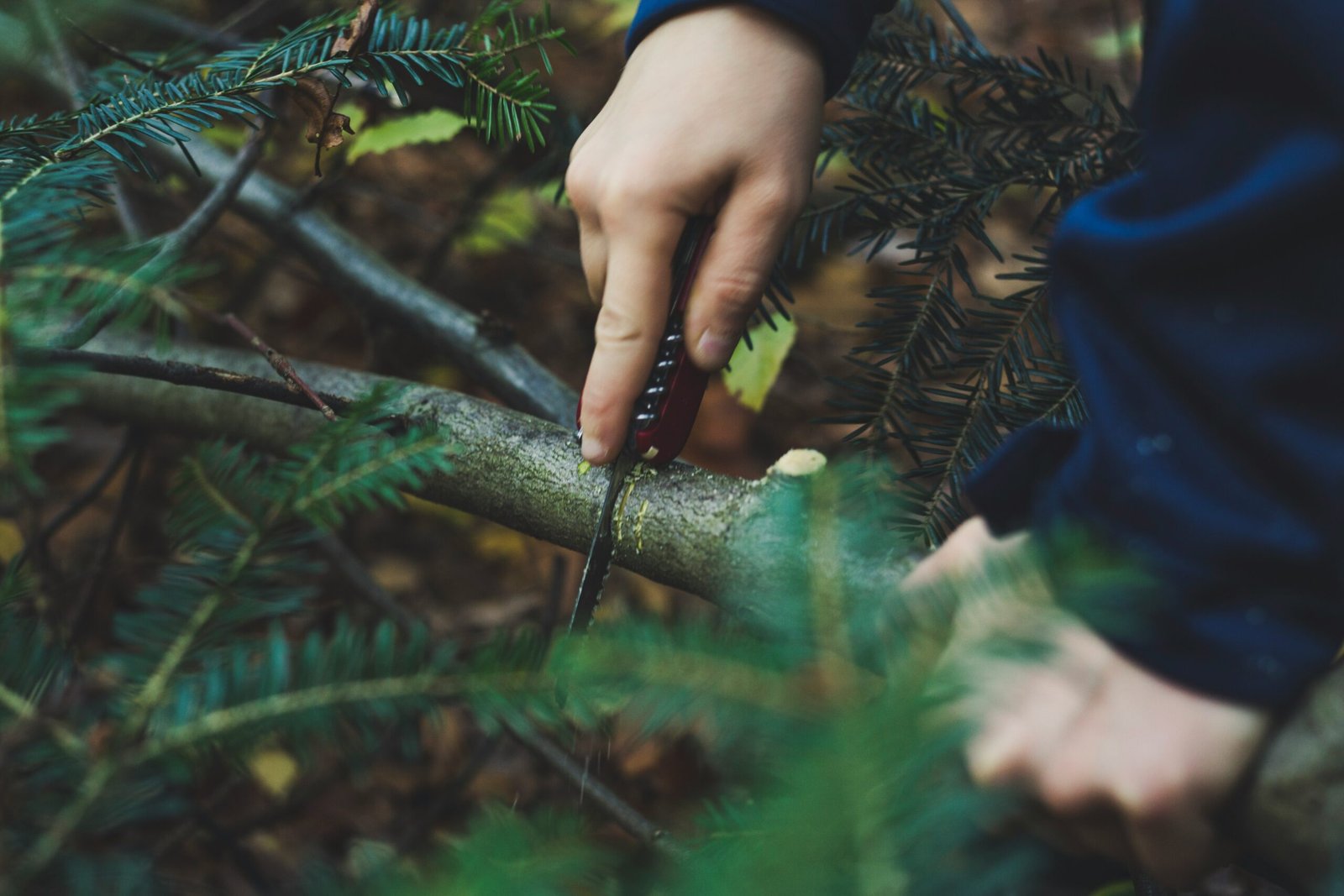
Introduction to Machetes
The machete is a versatile and formidable cutting tool, often defined by its broad blade and substantial length, typically ranging from 10 to 18 inches. Originating from various cultures, particularly in tropical regions, the machete has evolved into an indispensable tool used by farmers, laborers, and adventurers alike. Historically, this implement has served many purposes, including agriculture, forestry, and even combat. Its design not only makes it practical for clearing paths through dense vegetation but also allows for a range of applications in survival situations.
One of the key properties that set the machete apart from other cutting tools, such as knives and axes, is its balance between weight and cutting power. The elongated blade enables significant cutting force with minimal effort, facilitating tasks like chopping, slicing, and prying. This quality is especially advantageous in survival scenarios, where efficiency can be critical. In environments devoid of other tools, a machete’s versatility can be a game changer, assisting with tasks such as gathering firewood, preparing food, and self-defense.
In addition, the design of the machete often allows for various blade shapes, which can be tailored to diverse functions. For example, a curved blade may excel in slicing through thick underbrush, while a straight blade can effectively chop through larger materials. The applicability of a machete in different terrains, from jungles to deserts, further solidifies its status as an essential survival tool. Its lightweight construction and ease of handling allow users to employ it effectively, even in stressful situations.
Thus, the machete remains a timeless instrument, firmly rooted in both history and modern survival tactics. Its significance cannot be overstated, making it a requisite component in the gear of anyone venturing into the wild.
Clearing Pathways
In various survival scenarios, navigating through dense vegetation can pose significant challenges. One of the primary uses of a machete in these situations is clearing pathways, which is essential for ensuring safe and efficient movement through the wilderness. Dense brush, thick undergrowth, and small trees can obstruct one’s path, potentially leading to injuries or getting lost. A machete serves as a valuable tool to address these concerns effectively.
The long blade of a machete is specifically designed for chopping and slicing through tough materials, making it ideal for clearing pathways. With a few calculated swings, an individual can remove unwanted vegetation, thereby creating a clearer route for traversal. Unlike other tools, such as knives or axes, the machete’s length and weight allow it to cover a larger area with each movement, facilitating faster progress through challenging terrains.
Moreover, the versatility of a machete enables it to handle various types of foliage. Whether it’s cutting through thick vines, small branches, or overgrown grass, this tool can adapt to the task at hand. Additionally, disposing of the cut vegetation helps in maintaining visibility, which is crucial for avoiding potential hazards, such as hidden animal nests or uneven ground.
In survival situations, time is of the essence, and the ability to clear a pathway quickly can make a significant difference in safety and navigation. By employing a machete to clear a route, individuals not only enhance their mobility but also gain the confidence needed to venture further into wilderness areas. Ultimately, mastering the use of a machete for this purpose can be an invaluable skill for anyone facing survival challenges.
Building Shelters
In survival situations, a sturdy shelter is essential for protection against the elements, providing warmth, and ensuring safety from wildlife. A machete serves as a versatile tool for gathering and shaping materials necessary for constructing improvised shelters. Its long blade enables efficient cutting of branches and gathering of foliage, both of which are foundational elements in shelter construction.
To begin building a shelter, you can use the machete to cut down small trees or large branches. When selecting materials, look for strong, flexible limbs that can be bent to form the framework of the shelter. A common technique involves creating a lean-to structure, where one side of the shelter utilizes a sturdy vertical support, against which you can lean smaller branches. The machete allows for precise cutting of these supports, enabling you to shape them to the desired length.
After establishing the frame, you can use smaller branches and foliage to create a roof that provides coverage. The machete is useful in trimming these materials to size, ensuring they fit well onto your structure. A thatched roof, made from overlapping leaves or ferns, can be achieved by carefully cutting and layering the foliage, which enhances the shelter’s insulative properties.
Additionally, various other shelter designs, such as debris huts or tarps, can be constructed using a machete. The flexibility of the blade permits not only cutting through tough materials but also shaping them to fit together for optimal strength. It is advisable to consider local conditions, such as wind direction and potential rain, to inform your shelter design, thus ensuring a more effective protection strategy.
Overall, employing a machete as a primary tool for building shelters in survival situations provides a practical and effective means of constructing a safe haven. Its functionality extends from gathering materials to shaping them, making it an indispensable asset during outdoor emergencies.
Food Preparation
In survival situations, the ability to prepare food safely and efficiently is of utmost importance, and a machete can serve as an invaluable tool in this regard. Its sharp, robust blade makes it ideal for cutting a variety of food items, from fruits and vegetables to small game. When using a machete for food preparation, it is crucial to employ proper techniques to ensure safety and effectiveness.
To begin with, when cutting fruits and vegetables, positioning the item on a stable surface can help prevent accidents. A machete should be used with a firm grip and controlled downward motion to slice through tough skins or fibrous materials. For softer fruits, a gentle touch is necessary to avoid crushing them. Always ensure that the blade is sharp, as a dull machete is more likely to slip and cause injuries.
When it comes to hunting small game, a machete can be useful for dispatching the animal and processing its meat. Approach this task with respect and care, utilizing swift, precise cuts to minimize suffering. After hunting, cleaning the machete properly is essential to maintain hygiene and prevent contamination. Rinse the blade thoroughly, especially if it has come into contact with blood or other organic materials.
Another important aspect of food preparation with a machete lies in hygiene. Before any food processing, it is advisable to clean the blade with fresh water or a disinfectant to reduce the risk of foodborne illnesses. Additionally, after use, ensure the machete is dried and stored in a clean, safe place to prevent rust and degradation.
Overall, knowing how to effectively use a machete for food preparation can significantly enhance one’s survival skills. By practicing safe techniques and maintaining hygiene, one can successfully use this versatile tool in a variety of survival situations.
Chopping Firewood
In survival situations, maintaining an adequate supply of firewood is crucial for several reasons: warmth, cooking, and signaling for assistance. The machete serves as an effective tool for chopping firewood due to its length and sharpness, enabling increased leverage and cutting power. When selecting firewood, it is essential to choose the right type of wood. Opt for seasoned hardwoods, as these types typically burn longer and produce more heat than softwoods. Examples include oak, maple, or hickory, which are excellent choices for sustained burn and heat output.
When it comes to techniques for chopping firewood with a machete, proper stance and aim are vital. Stand with your feet shoulder-width apart for stability, and grip the machete firmly with both hands. A slight bend in your knees will provide a better base for striking downwards. Aim for larger branches or logs, targeting the center or weaker points to create clean cuts. Utilizing a chopping motion, raise the machete above your head and drive it down, using the weight of the blade to your advantage. It’s advisable to start with smaller pieces and work your way up as you build skill and confidence.
Once the firewood is chopped, preparing and maintaining a fire involves stacking the wood in a manner that promotes airflow, which is key for a long-lasting flame. Lay down a base of smaller sticks and kindling, then gradually add larger pieces. Be mindful of the fire’s needs: maintaining a manageable size that produces heat without excessive smoke is essential. To achieve this, regularly add chopped wood as needed while keeping the fire well-aerated. Following these guidelines not only enhances your fire-making abilities but ensures that warmth and cooking sources are readily available, contributing to your overall survival strategy.
5. Making Traps and Tools
In survival scenarios, the necessity of creating tools and traps is paramount for procuring food and ensuring safety. A machete serves as an invaluable instrument in this regard, capable of fashioning a variety of effective traps and survival implements using readily available natural materials. Its sharp blade and robust construction enable foraging in wilderness areas, where environmental resources can be creatively utilized.
One of the fundamental traps that can be constructed with a machete is the basic snare. This simple but effective trap can catch small game such as rabbits or squirrels. To create a snare, one must locate a path frequented by the animal. Using the machete, a flexible branch or vine can be cut to serve as the snare loop. The blade can also be employed to clear surrounding brush and set up a tension-triggered system, ensuring that the snare collapses around the prey when disturbed.
In addition to snares, a machete can be instrumental in building other traps like the deadfall. This trap utilizes a heavy object that is precariously positioned on a trigger mechanism. To create a deadfall, one would need to cut a stout branch as a trigger and a larger, heavier log as the falling weight, both of which can be fashioned with the machete. The tool allows for precise cuts and adjustments to set the trap effectively, ensuring proper bait placement to attract the game.
Moreover, the machete can facilitate the crafting of cutting tools and utensils for food preparation. Essential items such as fishing spears can be created using a longer, straight branch shaped with the machete. By sharpening one end and perhaps felling smaller branches for barbs, a makeshift fishing tool can be employed for survival fishing.
With these capabilities, it is clear that a machete is not merely a weapon but a versatile tool that enables survivalists to establish a means of gathering food and securing their sustenance in a challenging environment.
First Aid and Emergency Uses
In critical survival situations, the versatility of a machete extends beyond merely being a tool for cutting or clearing paths; it can also serve several emergency and first aid functions. Properly using a machete in such scenarios requires a careful balance of skill and caution to ensure safety while providing essential assistance. One significant application is the creation of splints, which can stabilize injured limbs. By selecting sturdy branches or materials nearby, a machete can facilitate the rapid crafting of effective splints, enabling stabilization of fractures until help can be reached.
Additionally, in the absence of traditional medical supplies, a machete can aid in creating bandages from available materials such as clothing or fabric. By utilizing the blade’s sharpness with precision, one can cut strips that are suitable for wrapping wounds or providing pressure to stop bleeding. It is crucial, however, to maintain cleanliness to minimize the risk of infection during these emergency first aid processes.
Moreover, a machete can also serve as a means of self-defense against potential threats, including wild animals. When faced with dangerous wildlife, having a machete at hand may provide a sense of security and an essential means of protection. The sheer presence of such a tool can deter threats, while a careful and well-executed swing may serve as a last resort if a confrontational scenario arises.
Nevertheless, it is vital to emphasize safety when employing a machete in emergencies. Improper handling can lead to accidents that complicate an already dire situation. Therefore, practicing sound judgment and maintaining awareness of surroundings while using a machete are paramount. Careful application of this versatile tool can greatly enhance survival chances, transforming it into an invaluable asset during critical moments.
Signal for Help
In survival situations, the ability to communicate distress or signal for help can be critical. A machete serves as a versatile tool for creating visible signals that can attract rescuers’ attention. One effective method is to use the machete to clear away vegetation and create large, discernible SOS signs on the ground. By cutting down branches, grass, and any obstructions, individuals can make their distress signal as prominent as possible, utilizing the natural contrast of the open earth against the surrounding greenery. The size and clarity of the SOS can significantly enhance visibility from the air or a distance.
Another approach to signaling for help with a machete involves the creation of smoke signals. By cutting branches from trees, individuals can gather materials to build a fire. Using dry leaves and other flammable debris will allow for an efficient fire that produces substantial smoke. The smoke can serve as a powerful visual signal, especially in open areas where it can be seen from afar. When making a fire, it is essential to manage it safely and ensure it does not become uncontrollable, as this can create more problems than it solves.
Furthermore, the reflective edge of a machete can be used as a signaling tool in sunlight. By angling the machete’s blade to catch sunlight and reflect it towards potential rescuers, individuals can create a flashing light that can travel considerable distances. This method is particularly helpful during the day, and when combined with other signals, it increases the chances of being spotted. In perilous situations, utilizing a machete in these ways emphasizes its importance not just as a tool for survival but also as a means of communication with the outside world.
Maintenance and Safety Techniques
When utilizing a machete in any survival situation, proper maintenance and safety practices are vital to ensure effective and safe operation. A well-maintained machete performs better and minimizes the risk of accidents. To keep your machete in optimal condition, regular sharpening is essential. This task can be accomplished with a sharpening stone or a specialized sharpening tool, focusing on maintaining a consistent angle of the blade while applying light, even pressure. Ensure that the cutting edge is free from nicks and damage, which can lead to ineffective cutting and increase the risk during use.
In addition to sharpening, it is important to clean the blade after each use. Removing debris, sap, or moisture can prevent rust and corrosion, extending the life of the tool. Applying a light coat of oil, such as mineral oil, can further protect the blade from the elements. Proper storage also plays a key role in maintenance; always store the machete in a secure sheath or case when not in use to prevent accidental injury and preserve the blade’s integrity.
Safety while wielding a machete cannot be overstated. The user must always be aware of their surroundings and maintain a safe distance from others while using the tool. It is advisable to employ proper cutting techniques, such as holding the machete firmly with both hands to maintain control and reducing the chance of slips. When making swings, ensure that the path is clear to avoid striking unintended objects or individuals. Additionally, it is wise to wear appropriate protective gear, including gloves, long sleeves, and eye protection, to safeguard against accidental cuts or flying debris. Mastery of these maintenance and safety techniques will enhance the utility of the machete in any survival scenario.
Conclusion and Final Thoughts
In examining the various applications of a machete in survival situations, it becomes abundantly clear that this versatile tool serves multiple essential functions. From clearing paths in dense vegetation to preparing food and crafting useful implements, the machete stands out as a cornerstone of survival gear. Throughout the discussion, we highlighted key uses such as chopping, splitting wood for fires, and building shelters. These functions not only enhance one’s chances of survival when stranded in the wilderness but also underscore the importance of versatility in survival equipment.
The strategic presence of a machete within a survival kit cannot be overstated. Its ability to adapt to varying roles—be it as a weapon for defense or a tool for crafting other implements—demonstrates its critical nature in any outdoor survival context. Moreover, understanding the importance of maintaining and properly utilizing this tool is paramount. Regular practice with a machete, as well as knowledge of its various uses, can make a significant difference in a high-pressure situation.
Encouraging readers to consider how and when to incorporate a machete into their outdoor adventures is vital. Preparation for survival situations should encompass not only the possession of this tool but also familiarity with its applications and care. As we reflect on the attributes that make a machete indispensable, it is evident that readiness and knowledge are equally as crucial as the tool itself. Ultimately, fostering skills relevant to one’s environment ensures that individuals can navigate unexpected situations with confidence, thereby enhancing personal safety and self-reliance.


